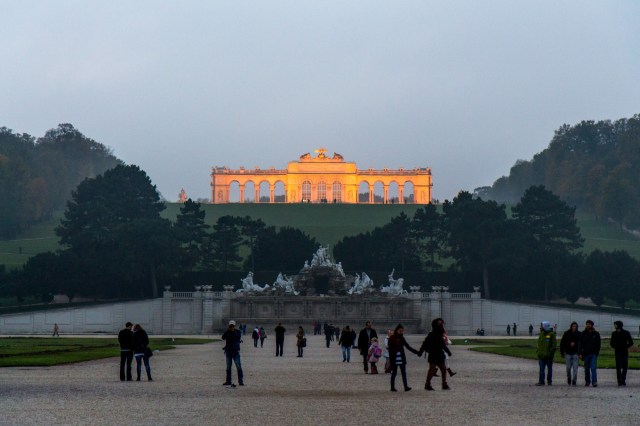Austria: Gloriette of Schönbrunn Palace at night, Vienna. Daniel Kalker/DPA/PA Images

The European Union is sometimes compared with previous attempts to create a multi-national super-state. Even allowing for the limitations of such parallels, most are inappropriate – e.g. the Roman Empire (too pre-European), the Holy Roman Empire (too German), the Napoleonic Empire (too French) and the Soviet Union (oh do grow up).
However, there is one candidate that does fit the bill: the Austro-Hungarian Empire (a.k.a. Austria-Hungary, the Austrian Empire or the Habsburg Empire). Though medieval in origin, it survived long enough into the industrial age to form recognisable governmental institutions and to face the challenge of democracy. Like the European Union it had, at its heart, a partnership between two nations (Austria and Hungary in place of France and Germany); but, also like the EU, there was no ethnic or linguistic majority. Factor in the combination of federal and national power structures, and it’s clear that the parallel, though inexact, is as close as we’re going to find.
To the extent that the English-speaking world remembers the Empire at all, it is as a ramshackle prison of nationalities, which finally collapsed at the end of the First World War. The true picture, however, is more complicated. In the New Criterion, Paul du Quenoy reviews The Habsburg Empire: A New History by Pieter M. Judson. Both the book and the review contain some highly relevant insights:
“Judson sets out to demonstrate that nationalism was not the corrosive agent of doom we all thought it was. In a provocative thesis covering the last 150 years of the Empire’s existence, he argues instead that nationalism… complemented rather than challenged imperial governance. The ‘nations’ that boldly asserted independence in late 1918 arose not from magically reawakened Herderian spirits of collective defiance but from deliberate measures taken by the imperial government itself to improve efficiency, undermine non-national sources of opposition, and—in its last decades—promote a supra-ethnic Habsburg patriotism based upon multiethnic inclusiveness and legally guaranteed civic equality.”
“Supra-ethnic patriotism”… “multiethnic inclusiveness”… “legally guaranteed civic equality”: does any of that sound familiar?
But how could the subject peoples of the Empire regard the remote Habsburgs as being on their side? It’s quite simple really – a case of ‘absence making the heart grow fonder’ versus ‘familiarity breeding contempt’:
“Peasants in the Empire’s underdeveloped… eastern marches could appeal to the dynasty in faraway Vienna for protection against their local feudal lords—even to the point of rising in violent rebellion against breaches of their traditional liberties under the banner of their just Habsburg rulers…”
For “eastern marches” read “peripheral member states”, for “Vienna” read “Brussels” and for “local feudal lords” read “corrupt national politicians”.
The parallels keep coming:
“Establishing local political legitimacy came to involve constructing government offices, theaters, libraries, gardens, museums, post offices, and other public spaces in a recognizably imperial style that self-consciously copied neoclassical Austrian institutional building, often even using the same ‘imperial yellow’ paint that still inscribes the architecture of officialdom everywhere from Western Ukraine to the Trentino-Alto Adige.”
Instead of yellow paint, just think about those blue-and-yellow flags on plaques on shiny new buildings across the Continent.
Presenting counter-arguments to Judson’s thesis, du Quenoy points to the Empire’s internal tensions, for instance:
“…the separate Hungarian parliament’s consistent refusal to fund the imperial military at internationally competitive levels, for nervous Magyar notables long feared that Vienna would use a larger and better-equipped imperial army to crush their jealously guarded autonomy. Clearly not everyone was as happy an imperial citizen as the anecdotal evidence suggests.”
Plenty of modern-day parallels for that sort of thing too.
Nevertheless, Judson’s key argument still stands: which that nationalism and supra-nationalism aren’t always contradictory – they can, for a time at least, form a working relationship. That is something the British (and especially the English) need to understand about their European neighbours. A different history, a different tradition, has shaped a different mindset.
Of course, it follows that this is something the Europeans need to understand about the British.










Join the discussion
Join like minded readers that support our journalism by becoming a paid subscriber
To join the discussion in the comments, become a paid subscriber.
Join like minded readers that support our journalism, read unlimited articles and enjoy other subscriber-only benefits.
Subscribe